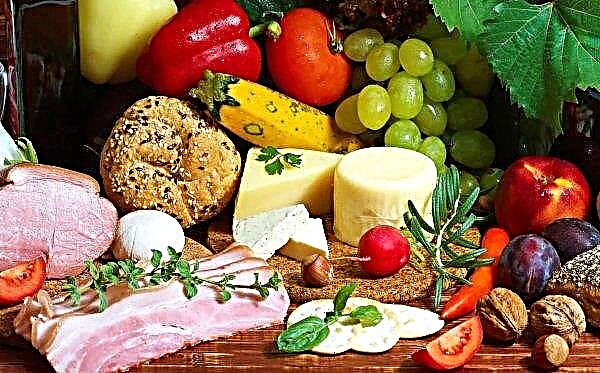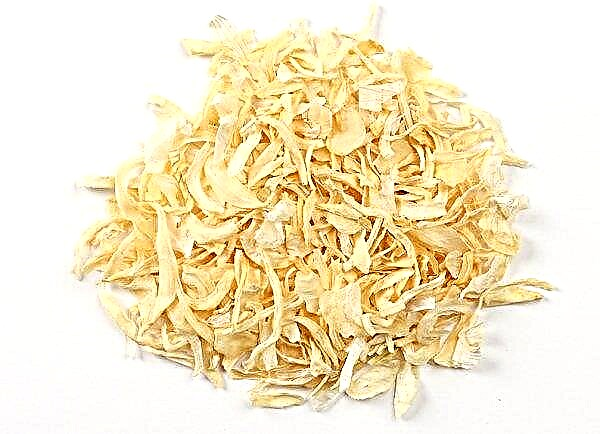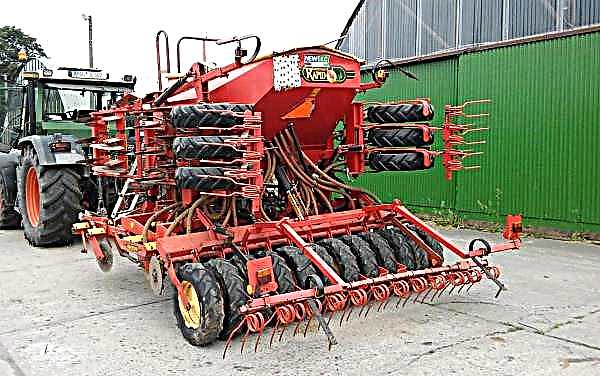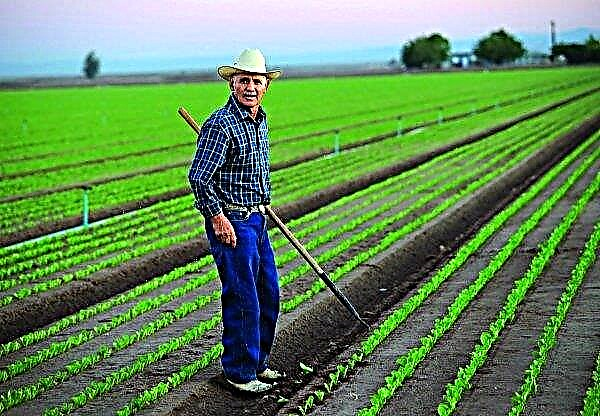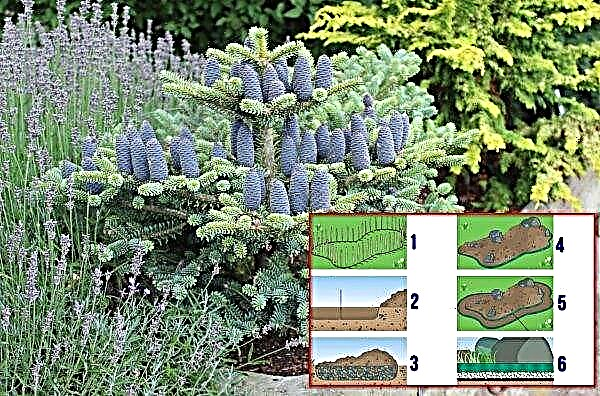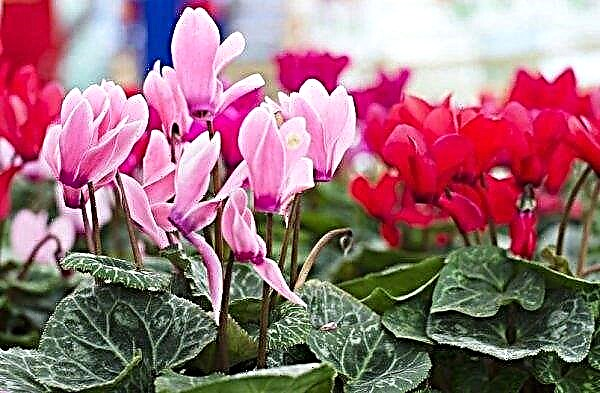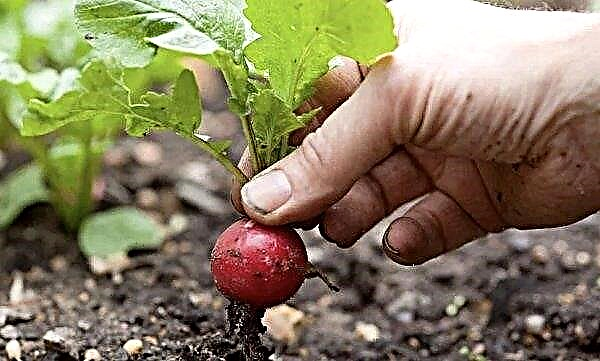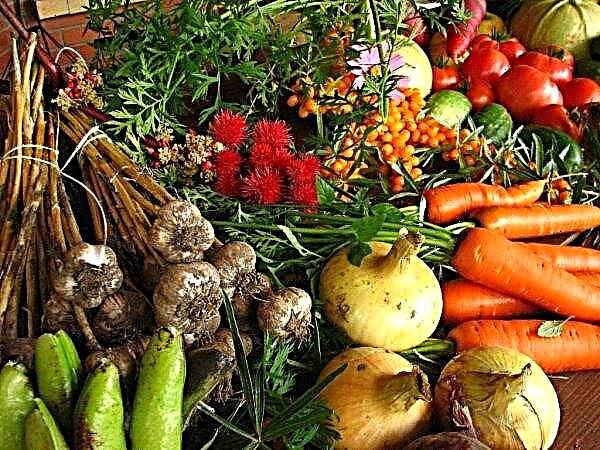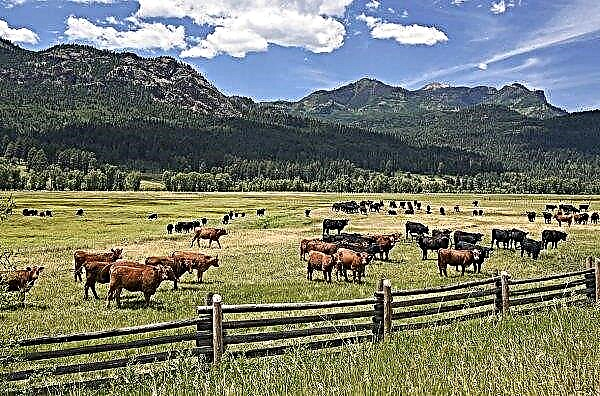Different varieties of mountain pine have long been used by gardeners and landscape designers for landscaping home gardens and city parks, and in order to achieve maximum efficiency from growing such a plant, it is important to choose the right variety. Along with many others, a good solution would be Benjamin pine, which will be discussed in the article about botanical features and cultivation.
Botanical tree description
Pine Benjamin, or Benjamin (Pinus mugo Benjamin) - a dwarf shrub grafted on the stem, with a flat-spherical shape of the crown at a young age and ideal spherical in the second half of his life. Each branch of the plant is complemented by many shoots, the growth of which is directed mainly upward. Thanks to them, the pine tree seems lush and dense, adding no more than 30 cm in growth annually. A ten-year-old tree reaches a height of no more than 30 cm, with a crown width of 40 cm. The height of an adult specimen, after decades of growing on a site, can be 70 cm, with a diameter crowns 90-100 cm.
The needles of the plant are collected in small bunches of 2 needles, each of which grows up to 5 cm in length. They are all hard to touch, young growths are bright, saturated green, while older ones have a dark green color, but with the same shiny surface. Light brown pineal-shaped ovoid fruits are always small in size, about 4 cm long. They do not spoil the appearance of the plant at all, therefore, even when fruiting adult pines, their beauty will not fade.
Landing
It’s logical to start planting mountain pine Benjamin by choosing the site that is most suitable for it, which will maximally meet the culture requirements for lighting, moisture level and soil composition. Generally, the plant belongs to the photophilous group, but at the same time it easily tolerates a small penumbra, prefers moisture, but does not tolerate overmoistening of the root system, which threatens diseases (especially fungal).
Did you know? The owner of the longest needles among pine species is a swamp pine, which boasts spiny processes up to 45 cm.
The culture successfully survives in areas with a completely different substrate, and in the natural environment of growth it is found on drained alkaline rocks: dolomites and limestones. If there are a large number of large-clastic inclusions in the landing pit, this is only a plus, therefore downed clay areas should preferably be supplemented with coarse sand or crushed limestone.
Video: Planting and caring for mountain pine
The frost resistance of such plants is high, and they can easily tolerate frosts down to –30 ° Cwhich can not be said about young seedlings: in the first few years of cultivation, they will need shelter for the cold season. Having picked up a suitable seat taking into account the above requirements of Benjamin pine, you can proceed to the direct planting of the purchased seedling.
Important! Do not use organic fertilizers when planting, much less put humus in the pit. On depleted soils, 50–100 g nitroammophoski mixed with the main substrate can be used.
Landing activities are carried out according to the following plan:
- First, dig a hole with a depth of at least 60 cm and a diameter of about 80 cm (the exact values will depend on the parameters of the rhizome of the young pine and its earthen coma).
- Lay a 15-cm layer of broken brick or expanded clay on the bottom of the pit, and then fill the pit with a mixture of two parts of turf land, one part of river sand and the same amount of peat to 1/3 of the volume. For better plant survival, you can add a small handful of nitrogen fertilizer to the substrate and mix everything well with the soil from the planting site.
- On the prepared earthen pillow, move the seedling, after carefully removing it from the shipping container. To facilitate this process, it is worth watering the plant in advance, and as soon as the soil becomes wet, transfer the earthen lump into the prepared hole.
- Fill the remaining voids with earth, form and condense the near-stem circle, and then water the seedling, spending at least one bucket of water on one instance.

If necessary, you can additionally mulch the surface with pine bark, peat or wood sawdust, forming a layer of no more than 5 cm from them.
Pine care
The main activities in the care of domestic vegetation will be timely watering, top dressing, soil maintenance in the near-stem circle and moderate pruning of the crown as necessary. All this is true when growing mountain pine varieties Benjamin, but each of these actions will have features.
Did you know? The highest variety of pine is deservedly considered Lambert pine, which in natural conditions of growth (in the United States and Canada) grows to 70–80 m in height.
Watering and feeding
Abundant and regular watering is required only for young, recently planted seedlings on the site who need time to adapt to the new conditions. The irrigation regularity in this case is 1-2 times a week, but with the obligatory taking into account the soil condition in the near-stem zone and the amount of natural precipitation. It is better to evenly distribute the irrigation fluid over the diameter of the planting hole, and on particularly hot summer days, additionally spray the culture with water in the evening (by sprinkling).

With age, the number of irrigations decreases and gradually reaches 2-3 times over the entire summer season, which greatly facilitates the gardener's task of care. In the first 2 years of growing pine on a site, it needs shading from the scorching sun, so when planting in an open area, you will have to create an artificial canopy on at least one side. This will prevent the rapid evaporation of moisture.
For feeding plants are mainly suitable only ready-made mineral fertilizers designed specifically for coniferous crops (for example, from the company "Agrekol" or "Biopon"). All that is needed when using them is to close the selected fertilizer into the loosened soil in a circle of a tree, and then water it well. The combination of watering and top dressing is the most convenient solution when caring for a plant.

Loosening and mulching
Loosening the soil is not a frequent procedure when growing an adult Benjamin pine, but for young, recently transplanted plants, it is often vital. A signal for the mandatory procedure is the appearance of a hard and cracked crust on the surface of the trunk circle, which indicates a limited flow of air and moisture to the roots. To normalize these processes, the soil is blown up with a rake, deepening the tool into the soil by no more than 10-15 cm. It is better to perform the procedure several days after the next wetting of the substrate, when the moisture has already completely absorbed.
To preserve the optimal characteristics of the soil, its fluffy surface layer should be covered with mulch, the role of which is suitable for natural materials: sawdust, mowed grass or shredded pine bark. Mulching of the near-trunk zone of the pine is carried out several times a season, focusing on the condition of the shelter already used.

Pruning
Benjamin does not need a pruning pruning, as the plant itself maintains its crown shape throughout the entire period of growth and development. The gardener is only required to promptly remove diseased, broken or improperly growing branches that thicken the crown. On adult plants, quite old shoots can be removed, with their subsequent replacement with a young growth.
Whatever the pruning, it is necessary to plan its implementation either in the early spring, before the active sap flow in the tissues of the culture begins, or after the leaves have fallen, when preparing the pine for wintering. All actions should be carried out only with a sharp and well-disinfected tool that will not leave any burrs in the places of cut and will not cause infection of the pine tree with various ailments.
Important! For one pruning, no more than 1/3 of all shoots available on the crown can be removed, otherwise the plant will be difficult to recover.
Possible diseases and pests
Like many other artificially produced pine varieties, Benjamin plants rarely suffer from pest attacks and the development of diseases, but if you violate the recommendations for caring for the crop, you should not exclude the possibility of their occurrence. Prolonged waterlogging of the soil can cause a tree to appear rust and all kinds of rot, the first signs of which will be yellowing and falling of needles, as well as the appearance of a grayish coating on the remaining green shoots.

For the treatment of ailments, it is worth using special fungicidal preparations in the form of “Scor”, “Rakursa” or “Oksikhoma”, the norms and features of the application of which are always indicated on the package. For greater effectiveness of the performed procedure, especially with massive pine damage, there will be a three- or four-fold treatment of plantings during the summer season. The interval between procedures should be at least three weeks.
Of the pests of mountain pine, Benjamin is sometimes annoyed aphid, spider mite and bugs, in the fight against which gardeners use insecticidal drugs: Aktara, Aktellik, Inta-Vir. Some of them (for example, Aktara) can be combined with the above fungicides, which will only increase the effectiveness of such treatments.

Use in landscape design
Benjamin pine has long been popular among gardeners, which is largely due to the compact size of the variety and its unpretentiousness in care. You can use the plant both in group plantings, and when creating single compositions using one conifer, but pine will look better in rockeries, rock gardens and stone gardens, although it is often planted in voluminous pots to decorate terraces, balconies and rooftop "home" gardens.
The plant reaches a peak of decorativeness in the winter, when the tops are covered with white, well-tarred buds.. True, in the rest of the year it does not suffer from a lack of attention and, for sure, it will be advantageous to stand out from the rest of the garden's vegetation.

The mountain pine variety Benjamin is a really good option for decorating a private territory, therefore, with a little effort to plant and further care for the conifer, you will get an excellent decoration of your site.

